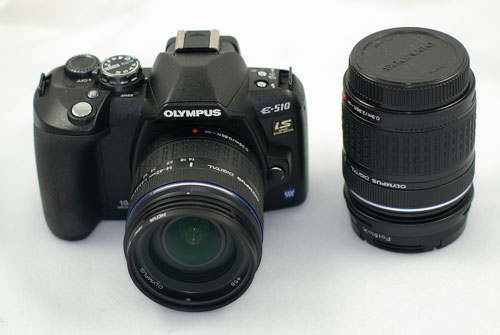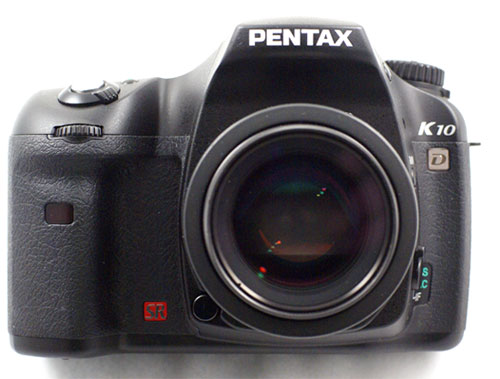Digital Camera Buyers' Guide - Year of the SLR
by Wesley Fink on November 23, 2007 6:00 AM EST- Posted in
- Digital Camera
Entry-Level Recommendations
Entry-level buyers don't normally have a collection of lenses for their new camera, so they are usually shopping for kits. Kit lenses are notorious for being mediocre, but that is improving in some of the kits we have recently seen. Our recommendations considered the quality and value of the kit itself, as well as the lens system for the entry DSLR buyers who end up enjoying digital photography and want to grow.

We are getting ready to be stoned, as our recommendation for best value in a kit is the 2-lens Olympus E-510 kit. The picture above is the complete kit, with both the 14-45mm f3.5-5.6 and tiny 40-150mm f4.0-5.6. These two small and light lenses cover the 35mm equivalent of 28mm to 300mm - a range from true wide angle to moderate telephoto. The 510 system finally realizes the promise of 4/3 with a small light body and small light lenses, but these two lenses are also two of the finest quality kit lenses available anywhere. This two-lens kit is available for as little as $675 at Amazon.com with free shipping, and you will find the E-510 two-lens kit at many web and brick-and-mortar stores for less than $800.
You get all the checklist features in this 10MP DSLR kit. This includes auto sensor cleaning and Live View as well as body integral image stabilization that works with all 4/3 lenses. This image stabilization - a first for Olympus - is selectable for either horizontal motion, which is generally best for panning and action, or both horizontal and vertical for general use, or off.
Olympus has improved their autofocus modules with each new generation, and the E-510 is the best one yet (outside of the E-3). However, the autofocus is still a weakness in an otherwise very capable system. It uses the somewhat dated 3-point autofocus, with a center cross sensor for greater sensitivity. In normal light, the E-510 is just as accurate and fast as other cameras, but it tends to search too much in low light conditions. Olympus introduced a fast and innovative 11 cross point 4-plane AF module in their new E-3. It needs to move down the line quickly to fix the last remaining issue with Olympus DSLR cameras. However, your reward with the E-510 is gorgeous, sharp, and evenly lighted lenses with the two kit lenses - and that is what photography is about.


Alternative: If low-light performance is a major concern, then you would do well to choose the Sony A100 kit with the 18-70mm kit lens. For a bit more money, the Pentax K10D gives you a great 11-point auto focus module, the truly useful hyperprogram feature that allows front and back dials to shift aperture and shutter speed in equivalent program steps, 3-plane image stabilization, all the other features, PLUS pro-type dust and moisture sealing.
The Safe Choice: The safe choice, and the one most buyers will make, is the Canon Rebel XTi or the Nikon D40x with the pedestrian 18-55mm kit lens. The problem with either choice is they don't include image stabilization, which is most useful with the slow kit lenses most camera makers sell with their entry cameras. In their favor, Canon includes auto sensor cleaning, but Nikon doesn't even bother with that. Nikon does provide a bit better image quality with their 18-55mm, so that makes it something of a toss-up.
It appears both Nikon and Canon are being hurt somewhat by their lack of mechanical image stabilization since they have both announced the availability of their basic kit lens with optical image stabilization. Yes, you will be seeing these IS and VR versions of the 18-55mm in future Canon and Nikon kits. There are arguments that can be made for optical IS instead of the mechanical body-integral IS that works with all lenses. However, the thought of spending more for the Canon 18-55mm with IS is difficult to stomach. What these announcements really say is Canon and Nikon are still resisting IS as a standard feature, though they are addressing this as a checklist item with IS/VR versions of their entry kit lens.










74 Comments
View All Comments
andrew007 - Friday, November 23, 2007 - link
Oh yeah, almost forgot. There is one more complaint - focus hunting. I never had a SLR before so I can't compare but it seemed to me that E410 has trouble focusing in some situations (not just low light) more than an DSLR should. It does have the least focus points of any DSLR if I remember correctly so that may be the reason. In the end I often just use the center sensor and manually lock focus, then do the composition.haplo602 - Friday, November 23, 2007 - link
Hey nice to see the new DSLR buyers guide.I'd comment on the missing Pentax K10D, but who cares ? No Live View, only 10MP, 22bit A/D, dust and weather sealed, image stabilisation. AND a VERY long supply of high quality Pentax lenses... sub 1000$ ... but who cares ? It's last year news (tho you cover olympus 410/510 which are also not new).
I see you adapted the computer world obsession for numbers and new models. Get rid of it. Fast.
If I would buy a new DSLR now it would be either Pentax K10D (and I own a few Nikon lenses) or the Nikon D300 (but this is the more expensive decision).
Frumious1 - Friday, November 23, 2007 - link
Yes, I'd comment on the missing Pentax K10D... except it's already on page 5."Alternative: If low-light performance is a major concern, then you would do well to choose the Sony A100 kit with the 18-70mm kit lens. For a bit more money, the Pentax K10D gives you a great 11-point focus module, all the other features, and pro-type dust and moisture sealing."
haplo602 - Monday, November 26, 2007 - link
Ah ... I knew I missed the Pentax section with nice picture of the K10D and a 1/2 page description like all the others got ... NOT !melgross - Friday, November 23, 2007 - link
I don't understand the statement here that only full frame and 4/3 are standard. This seems to be some prejudice on the part of the writer, who seems to be pushing Olympus very strongly.The APS "C" sensor is more standard than is the 4/3. Just take a look at how many companies are producing "C" sensors, and how many are producing 4/3.
That said, my 5D does produce some of the best pictures around (though I'm looking forward to its expected replacement at the PPA in March.
lumpy327 - Friday, November 23, 2007 - link
Glad to see this column back!! Good article overall, but I wish Pentax had been included too, I miss HyperProgram from my film camera.As a photography student, I'd like to add my two pennies worth to deciding on what camera.
First, if you have good lenses from older cameras, consider sticking w/ that brand. Bodies are cheap compared to good lenses, and there are good, in-depth reviews of lenses, like lightrules, on the web.
Second, there are plenty of reviews of cameras on the web, so do your homework. Look for fast autofocus, and just as important, low light auto focus speed, w/ and w/o flash and w/ and w/o image stabilization. Trying to get pictures of your childs face on christmas WILL SUCK if your camera keeps hunting and strobing the flash, then picks a bulb on the tree to focus on. Try to pony up for image stabilization, it really helps to get pictures in low light w/o using the flash, and most pictures w/o on camera flash are much nicer. Just to put autofocus in perspective, I'm a pentax guy that uses a canon, but if the d300's 51 point autofocus works as well as it should, I'd seriously consider switching.
Closely related to this is ISO number. Look for the lowest noise at the highest iso numbers. Many websites include crops of pictures at all iso numbers, check them to to see if its worth going to ISO1600. I'll say this, most sensors do well to ISO800 if exposed properly and to ISO1600 if exposed properly and kept highkey.
(don't worry about daylight, outdoor shots, most DSLR's and their lenses do well in bright light.)
Third, if your coming from a P&S, try get live view or what ever its called. It's very difficult to learn to keep the view finder up to your eye; if you see it thru the view finder, you missed the shot. Thats just the way DSLR's work.
I hope this helps, even if its just one person. These cameras are not cheap, and its way too easy to overbuy, like I did. EOS 30D owner.
JCheng - Friday, November 23, 2007 - link
The D300 shipped on Wednesday--I have one in my hands.Lord 666 - Thursday, November 29, 2007 - link
I got mine last night and ho-hum about it as I upgraded from a D80. The ISO range is a welcome improvement, but need to spend some more time with it this weekend to feel it out. Set the deadline of this Sunday if I am going to return it. Need to do some more comparison shots using the 18-200 VR lens over the next couple days.Heidfirst - Friday, November 23, 2007 - link
It's nice to see someone who isn't totally CaNikon blinkered.The OM E510 looks to be a very good camera & even cheap in the UK too (Olympus rebates) as is the Pentax K10D.
The Sony A700 looks to at least match if not better the EOS 40D although it's a bit dearer.
& Sony A100 apparently is due for replacement Q1 2008 so that could be another interesting camera to watch out for.
It's an extremely competitive market so prices are falling & there are no bad DSLRs so it's a win all round for the consumers.
StephenP - Friday, November 23, 2007 - link
The Sony=Supplier for Nikon sensors so the next pro Sony will be full-frame argument isn't valid for full frame... The D3 uses a Nikon inhouse developed sensor, unless ofcourse Sony borows it from Nikon.